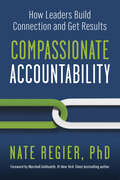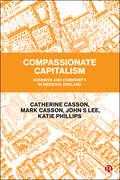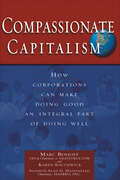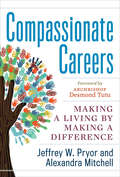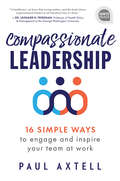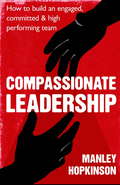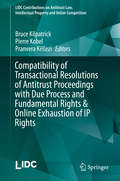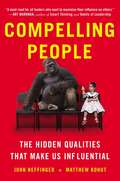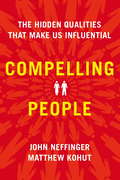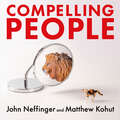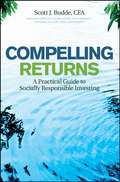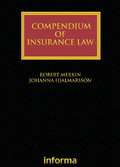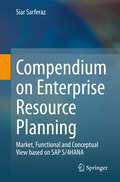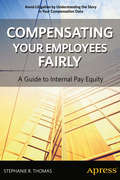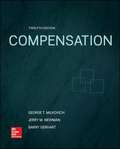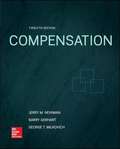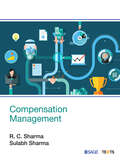- Table View
- List View
Compassion: An Essential Element of Resonant Leadership
by Annie Mckee Richard BoyatzisLeaders develop their resonance and renew themselves by cultivating three essential elements: mindfulness, hope, and compassion. This chapter highlights the concrete leadership benefits of compassion, looking at how effective leaders embrace it and employ it in their lives and work.
Compassionate Accountability: How Leaders Build Connection and Get Results
by Nate Regier PhDA compass for leaders lost in the paradoxical space between attention to people and attention to results—with Compassionate Accountability you don't have to choose! Sadly, compassion and accountability are too often in tension-leaders feel they have to pick one or the other. But solely prioritizing accountability can create toxic work environments that drive away good talent. On the other end of the spectrum, being too nice can compromise performance and productivity.Finding harmony between compassion and accountability is the ultimate catalyst for improved results and a thriving workplace. The solution is recognizing that compassion and accountability are not opposites. In fact, accountability is an element of compassion. Compassionate Accountability is the process of building connection while getting results. This book shows how this foundational mindset, philosophy, and way of living can lead to a thriving organizational culture. It covers such topics as these: Why you can't practice compassion without accountabilityHow to turn on the three switches of the compassion mindset—and the predictable damaging consequences when they're turned offThe key role Compassionate Accountability plays in a healthy leadership culture Six areas to focus on to start building your culture of Compassionate AccountabilityFive common barriers to compassion for leaders—and how to overcome themPlus, readers will find real case examples of how organizations have adopted Compassionate Accountability, along with quizzes and self-assessments to help them learn and apply the concepts. Leaders seeking a renewed sense of fulfillment in their roles and increased leadership impact will find inspiration, guidance, and a road map for cultural transformation.
Compassionate Capitalism: Business and Community in Medieval England
by Mark Casson Catherine CassonIt may seem like a recent trend, but businesses have been practising compassionate capitalism for nearly a thousand years. Based on the newly discovered historical documents on Cambridge’s sophisticated urban property market during the Commercial Revolution in the thirteenth century, this book explores how successful entrepreneurs employed the wealth they had accumulated to the benefit of the community. Cutting across disciplines, from economic and business history to entrepreneurship, philanthropy and medieval studies, this outstanding volume presents an invaluable contribution to our knowledge of the early phases of capitalism. A companion book, The Cambridge Hundred Rolls Sources Volume, replacing the previous incomplete and inaccurate transcription by the Record Commission of 1818, is also available from Bristol University Press.
Compassionate Capitalism: How Corporations Can Make Doing Good an Integral Part of Doing Well
by Marc Benioff Karen SouthwickThe coauthors are uniquely suited to bring this important issue to light. Marc Benioff is CEO and chairman of Salesforce.com foundation. Salesforce.com has received the Award for Excellence in Corporate Community Service by the Points of Light Foundation and Volunteer Center National Network and the first ever U.S. Chamber of Commerce Corporate Stewardship Award. A former sales and marketing executive at Oracle Corporation, Benioff is now devoting his considerable talent and energy to building an integrated technological business and philanthropic models.
Compassionate Careers: Making a Living by Making a Difference
by Jeffrey W. Pryor Alexandra MitchellFor those who feel that sitting on the sidelines just isn’t enough: A guide to finding meaningful work in cause-centered organizations.If you want a job that gives you not just a paycheck but a purpose, Compassionate Careers is an inspiring guide to get you started on your path. Filled with examples of people who have meaningful jobs in cause-focused organizations, it includes:Stories from people of all walks of life who have jobs that make a difference, including famous figures like Bill Clinton, Jane Goodall, and Dave MatthewsInformation on how to get started in a cause-focused careerAn online assessment that identifies the type of organizational culture for which you are best suitedExercises and resources for hands-on exploration of compassionate career opportunitiesAn old Yaqui Indian proverb says, “If you have a choice of paths to take in life, take the path with a heart.” Compassionate Careers will show you how.“Life’s too short for you not to wholeheartedly pursue your gifts and passions. If you find the right mission and the right role within that mission, that’s such a powerful thing. But Compassionate Careers also does a favor for people in that it’s not candy coated. There are real tradeoffs, and it helps people think about how to navigate that path.” —Jonathan Reckford, CEO, Habitat for Humanity
Compassionate Leadership: 16 Simple Ways to Engage and Inspire Your Team at Work (Ignite Reads)
by Paul AxtellLearn how to be a good boss and become the leader everyone wants to work for.People want to work for someone they respect, someone who is on their side. And when employees feel seen, heard, and valued by their supervisors, employee engagement improves, productivity increases, and the entire organization benefits.In his new motivational management book on authentic leadership, award-winning author and personal effectiveness trainer and consultant Paul Axtell reveals sixteen simple steps you can start taking right now to develop your emotional intelligence and leadership skills and become a manager who leads with compassion.This leadership development book is a quick one-hour read and is for any business leader or manager looking to improve their organizational leadership in order to lead high-performing teams that—above all else—feel trusted, respected, and motivated in their work.
Compassionate Leadership: How to create and maintain engaged, committed and high-performing teams
by Manley HopkinsonForcing compliance is easy. Anyone can 'make' another do a task or a job. It will get done, but when, and to what standard? High performance and, more importantly, sustained high performance can only come from engagement with and commitment to the job in hand. This book will introduce you to the art of compassionate leadership - the art of getting the best for and out of people through the fulfilment of self-worth. It will show leaders how to give their teams a real sense of purpose and direction in order to motivate and inspire them to perform at a high level. To illustrate his message, author Manley Hopkinson draws on his background as a board member of companies including ATLAS Consortium and Hewlett Packard Defence UK, his career as an inspirational speaker and his adventure experiences as skipper in the BT Global Challenge (a round the world yacht race) and The Polar Race (an expedition style race to the Magnetic North Pole).
Compassionate Samurai: Being Extraordinary In An Ordinary World
by Brian KlemmerIn life there are two types of people. The first are those who are nice, good-hearted, and compassionate but can't make much happen. The other kind can make everything happen-they're the creators, the go-getters, and the aggressive producers in society-however, they're often self-centered, greedy, and unethical. Wouldn't it be great if you could make things happen in a really big way but not lose your integrity? The Compassionate Samurai will show you the way to produce extraordinary results in a dog-eat-dog world and still maintain the highest levels of ethics. You'll learn: How to always be satisfied and motivated regardless of your circumstances Why all people have freedom but very few have liberty What competing commitments are and how they prevent you from having what you want in life The secret to operating optimally in an untrustworthy environment • How to make the shift from scarcity to abundance even if you're knee deep in debt . . . and much, much more!
Compatibility of Transactional Resolutions of Antitrust Proceedings with Due Process and Fundamental Rights & Online Exhaustion of IP Rights (LIDC Contributions on Antitrust Law, Intellectual Property and Unfair Competition)
by Bruce Kilpatrick Pierre Kobel Pranvera KëlleziThis bookprovides an unparalleled comparative analysis of two "hot topics" inthe field of antitrust and unfair competition laws with regard to a number ofkey countries. The first partof the book examines the consistency and compatibility of transactionalresolutions of antitrust proceedings (such as settlement procedures, leniencyprogrammes and commitments) with due process and the fundamental rights of theparties. This is a particularly important topic, given the widespread adoptionof these procedures by anti-trust authorities worldwide. The individual chaptersconsider how the leniency, settlement and commitments procedures have developedacross a range of jurisdictions, and discuss the extent to which checks andbalances have been applied in those national procedures in order to safeguardthe fundamental rights of the parties involved. A detailed international reportidentifies general trends and highlights the differences between and most interestingfeatures of national regulations. The second partof the book gathers contributions from various jurisdictions on the unfaircompetition-related question of the online exhaustion of IP rights. As commerceis increasingly moving online, the respective chapters consider the extent towhich exhaustion and similar concepts have adapted to these rapid changes. Thecomprehensive and insightful international report brings together thesereflections by comparing various national positions. The book alsoincludes the resolutions passed by the General Assembly of the LIDC following adebate on each of these topics, which include proposed solutions andrecommendations. The internationalLeague of Competition Law (LIDC) is a long-standing international associationthat focuses on the interface between competition law and intellectual propertylaw, including unfair competition issues.
Compelling People: The Hidden Qualities That Make Us Influential
by John Neffinger Matthew KohutHow People Judge You#151;And How To Come Out Looking Good Required Reading at Harvard Business School Everyone wants to know how to be more influential. But most of us don’t really think we can have the kind of magnetism or charisma that we associate with someone like Bill Clinton or Oprah Winfrey unless it comes naturally. Now, in Compelling People, which is already being taught at Harvard and Columbia Business Schools, John Neffinger and Matthew Kohut show that this isn’t something we have to be born with#151;it’s something we can learn. Expanding on the themes in their co-authored Harvard Business Review cover story #147;Connect, Then Lead,” they trace the path to influence through a balance of strength (the root of respect) and warmth (the root of affection). Each seems simple, but only a few of us figure out the tricky task of projecting both at once. The ability to master this dynamic is so rare that we celebrate and elevate those people who have managed to do it Drawing on cutting-edge social science research as well as their own work with Fortune 500 executives, members of Congress, TED speakers, and Nobel Prize winners, Neffinger and Kohut reveal: The common thread connecting Machiavelli and Martin Luther King The secret technique behind the success of Bill Clinton, Ann Richards and Denzel Washington#151;one that you can use today How looks affect our career prospects The single best strategy for getting someone to agree with you Compelling People explains how we size each other up#151;and how we can learn to win the admiration, respect, and affection we desire.
Compelling People: The Hidden Qualities That Make Us Influential
by John Neffinger Matthew Kohut'This is not just another pop-psych book: it's the first book to capture and share the insights from all the recent groundbreaking research on how we judge and persuade each other. And it translates that into simple, practical terms anyone can use to build more effective relationships at the office or home' Amy CuddyHOW PEOPLE JUDGE YOU - AND HOW TO COME OUT LOOKING GOOD Everyone wants to know how to be more influential. But most of us don't really think we can have the kind of magnetism or charisma that we associate with someone like Bill Clinton or Oprah Winfrey unless it comes naturally. In Compelling People - now required reading and Harvard Business School - John Neffinger and Matthew Kohut show that this isn't something we have to be born with, it's something we can learn. They trace the path to influence through a balance of strength and warmth. Each seems simple, but only a few of us figure out the tricky task of projecting both at once. Drawing on cutting-edge social science research as well as their own work with Fortune 500 executives, members of Congress, TED speakers and Nobel Prize winners, Compelling People explains how we size each other up - and how we can learn to win the admiration, respect, and affection we desire.
Compelling People: The Hidden Qualities That Make Us Influential
by John Neffinger Matthew Kohut'This is not just another pop-psych book: it's the first book to capture and share the insights from all the recent groundbreaking research on how we judge and persuade each other. And it translates that into simple, practical terms anyone can use to build more effective relationships at the office or home' Amy CuddyHOW PEOPLE JUDGE YOU - AND HOW TO COME OUT LOOKING GOOD Everyone wants to know how to be more influential. But most of us don't really think we can have the kind of magnetism or charisma that we associate with someone like Bill Clinton or Oprah Winfrey unless it comes naturally. In Compelling People - now required reading at Harvard Business School - John Neffinger and Matthew Kohut show that this isn't something we have to be born with, it's something we can learn. They trace the path to influence through a balance of strength and warmth. Each seems simple, but only a few of us figure out the tricky task of projecting both at once. Drawing on cutting-edge social science research as well as their own work with Fortune 500 executives, members of Congress, TED speakers and Nobel Prize winners, Compelling People explains how we size each other up - and how we can learn to win the admiration, respect, and affection we desire.
Compelling Returns
by Scott J. BuddeAchieve competitive financial returns and make a difference at the same time by applying the information in Compelling Returns: A Practical Guide to Socially Responsible Investing, a well-rounded guide to socially responsible investing (SRI). Understand the basics of SRI and discover how you can align your values with your investments by choosing from three basic strategies. Learn to implement these strategies in your investment portfolios and combine your newfound knowledge with the basic principles of successful investing. An up-to-date directory of companies involved with SRI is included.
Compendium of Insurance Law (Lloyd's Insurance Law Library)
by Robert Merkin Johanna HjalmarssonThe Compendium of Insurance Law consolidates diverse insurance law sources, statutes and codes of practice in one comprehensive volume. Each piece of legislation is supplemented by detailed annotations, which explain the operation and relationship of the legislation with other sources of insurance law. The book is filled with comprehensive coverage of legislation relating to the following areas: regulation, reinsurance, life assurance, property insurance, marine insurance, liability insurance, motor insurance, insurance intermediaries, insurance contracts and competition.
Compendium on Enterprise Resource Planning: Market, Functional and Conceptual View based on SAP S/4HANA
by Siar SarferazThis book explains the functional scope, the data model, the solution architecture, the underlying engineering concepts, and the programming model of SAP S/4HANA as the most well-known enterprise resource planning (ERP) system. The approach is to start with general concepts and then to proceed step-by-step to concrete implementations in SAP S/4HANA. In the first part the reader learns about the market view of ERP solutions and vendors. The second part deals with the business processes for sales, marketing, finance, supply chain, manufacturing, services, procurement, and human resources which are covered with SAP S/4HANA. In the third part the underlying concepts of SAP S/4HANA are described, for example in-memory storage, analytics and search, artificial intelligence, process and data integration, security and compliance, lifecycle management, performance and scalability, configuration and implementation. The book is concluded with a final chapter explaining how to deploy an appliance to explore SAP S/4HANA. The target audience for the book are managers and business analysts who want to understand the market situation and future ERP trends, end users and process experts who need to comprehend the business processes and the according solution capabilities provided with SAP S/4HANA, architects and developers who have to learn the technical concepts and frameworks for enhancing SAP S/4HANA functionality, and consultants and partners who require to adopt and configure SAP S/4HANA.
Compensating Wounded Warriors: An Analysis of Injury, Labor Market Earnings, and Disability Compensation Among Veterans of the Iraq and Afghanistan Wars
by Paul Heaton David S. Loughran Amalia R. MillerThis comprehensive, quantitative assessment of how injury sustained by service members deployed to Iraq and Afghanistan affects their subsequent labor market earnings also explores the extent to which retirement and disability payments compensate for any resulting earnings losses. The analysis controls for a rich array of individual-level characteristics, including labor market outcomes prior to deployment.
Compensating Your Employees Fairly: A Guide to Internal Pay Equity
by Stephanie R. ThomasCompensation fairness is a universal preoccupation in today''s workplace, from whispers around the water cooler to kabuki in the C-suite. Gender discrimination takes center stage in discussions of internal pay equity, but many other protected characteristics may be invoked as grounds for alleging discrimination: age, race, disability, physical appearance, and more. This broad range of vulnerability to discrimination charges is often neglected in corporate assessments of how well compensation systems comply with the law and satisfy employee norms of fairness. Blind spots in general equity constitute a serious threat to organizational performance and risk management. In Compensating Your Employees Fairly, a respected practitioner and consultant lays out in practical terms everything you need to know to protect your company along the full spectrum of internal pay equity issues, including all the technical methods you need to optimize compliance and minimize risk. Compensating Your Employees Fairly is a timely survey and comprehensive handbook for compensation specialists, HR professionals, EEO compliance officers, and in-house counsel. It provides all the information you need to ensure that compensation systems are equitable, auditable, internally consistent, and externally compliant with equal employment opportunity laws and regulations. The author presents technical information--both legal and statistical--in common-sense terms. Her non-technical breakdown of complex statistical concepts distills just as much as practitioners need to know in order to effectively deploy and interpret the standard applications of statistical analysis to internal pay equity. The focus throughout the book is on real-world application, current examples, and up-to-the-minute information on recent and pending wrinkles in the evolving legal landscape. Readers of Compensating Your Employees Fairly will learn: Why internal equity in compensation matters How to detect intentional and non-intentional discrimination in compensation The basics of statistical inference and multiple regression analysis The essentials of data availability, measurability, and collection The criteria for assessing compensation systems for internal equity How to investigate potential problems and react to formal complaints and actions How to avoid litigation and put in place ongoing measures for proactive self-auditing What you''ll learn Readers of Compensating Your Employees Fairly will learn: Why internal equity in compensation matters How to detect intentional and non-intentional discrimination in compensation How to investigate potential problems and react to formal complaints and actions How to avoid litigation and put in place ongoing measures for proactive self-auditing Who this book is for HR professionals, compensation specialists, EEO compliance officers, in-house counsel, and employment attorneys will find invaluable the expert author''s non-technical treatment of the technical issues that are essential to understanding all facets of internal pay equity. Without a working understanding of how to make their data tell a clear story, these various professionals cannot ensure that their compensation systems are equitable, auditable, and demonstrably compliant with equal employment opportunity laws and regulations. Table of Contents Why Equity in Compensation Matters Types of Discrimination in Compensation Multiple Regression Analysis The Data Regression Models of Equal Pay Other Tests of Equal Pay Analysis Follow-Up The Changing Landscape of Pay Equity Enforcement Causes of the Gender Pay Gap Litigation Avoidance and Proactive Self-Analysis The Basics of Statistical Inference
Compensation
by Barry Gerhart George Milkovich Jerry NewmanCOMPENSATION by Milkovich and Newman is the market-leading text in this course area. It offers instructors current research material, in depth discussion of topics, integration of Internet coverage, a modern design, excellent pedagogy, and a truly engaging writing style. George Milkovich and Jerry Newman are viewed as leading authorities in the field of Human Resource Management/Compensation. They consult with leading businesses, have won teaching awards, and publish in the leading journals. Milkovich received a career contribution award from WorldatWork (formerly American Compensation Association) in 2000. COMPENSATION examines the strategic choices in managing total compensation. The total compensation model introduced in chapter one serves as an integrating framework throughout the book. The authors discuss compensation issues in the context of current theory, research, and real-business practices. Milkovich/Newman strive to differentiate between beliefs and facts, and opinions from scholarly research. Adopters tell us that students get job offers based on the knowledge they get from this book.
Compensation (12th Edition)
by George T. Milkovich Jerry M. Newman Barry A. GerhartBest selling title. Tackles major compensation from three sides: theory, research, and practice - no situation can survive that onslaught! The 12th edition continues to emphasize the importance of total compensation and its relevance for achieving sustainable competitive advantage. Beyond how much people are paid, how they are paid matters too. Managing pay means ensuring that the right people get the right pay for achieving objectives in the right way.
Compensation Management
by R. C. Sharma Sulabh SharmaCompensation Management presents a comprehensive account of the intricacies related to compensation and reward management in Indian organizations - a vital strategic feature of HR management. The book covers fundamental concepts of the subject along with the approaches, tools, techniques and allied issues. Starting with conceptual framework, it discusses wage determination and wage fixation practices in India, salary reviews and reward management policies, and processes and procedures, in addition to international remuneration with special reference to expatriates and the remuneration of third country nationals. It blends theoretical concepts with real-life practices followed in the corporate sector, with a focus on Indian organizations. This book would be helpful to students of human resource management, business economics, public administration, social work and other allied fields. Key Features: • Covers the role of art and science of compensation management in raising the competitive edge of organizations • Focuses on recent policy developments, contemporary industry-wide changes and probable strategies for issues discussed • Key pedagogical features, including contemporary case studies and activities
Compensation and Organizational Performance: Theory, Research, and Practice (Human Resources Management Ser.)
by Luis R. Gomez-Mejia Pascual Berrone Monica Franco-SantosThis up-to-date, research-oriented textbook focuses on the relationship between compensation systems and firm overall performance. In contrast to more traditional compensation texts, it provides a strategic perspective to compensation administration rather than a functional viewpoint. The text emphasizes the role of managerial pay, its importance, determinants, and impact on organizations. It analyzes recent topics in executive compensation, such as pay in high technology firms, managerial risk taking, rewards in family companies, and the link between compensation and social responsibility and ethical issues, among others. The authors provide a thorough and comprehensive review of the vast literatures relevant to compensation and revisit debates grounded in different theoretical perspectives. They provide insights from disciplines as diverse as management, economics, sociology, and psychology, and amplify previous discussions with the latest empirical findings on compensation, its dynamics, and its contribution to firm overall performance.
Compensation and Performance Evaluation at Arrow Electronics
by Brian J. Hall Carleen MadiganDescribes a company's struggles in implementing a subjective performance rating system for its employees. In particular, it describes the difficulties faced by the CEO in getting managers to combat "ratings inflation"--that is, to produce numerical ratings that are both differentiated and "not too high."
Compensation and Reward Management: Wage and Salary Administration and Benefits
by Sulabh Sharma R. C. SharmaThis book presents a comprehensive account of the intricacies related to compensation and reward management in Indian organizations—a vital strategic feature of HR management. It presents a blend of theoretical concepts, definitions, approaches, methods and techniques related to compensation practices being followed/likely to be followed in organizations. Starting with a conceptual framework, it discusses wage determination and wage fixation practices in India, salary reviews and reward management policies, and processes and procedures, in addition to international remuneration with special reference to expatriates and the remuneration of third country nationals. In addition to examining the designing and monitoring of salary grade structures including salary progression curves, it spells out divergent systems and institutions for wage determination/wage fixation practices in Indian organizations.Rich in pedagogical features, including learning objectives, discussion questions, individual and group activities, the volume also has numerous case studies. This book will be useful to students of human resource management, business economics, corporate finance, corporate governance, organizational studies, strategic management, finance, business and industry, public administration, social work and other allied fields.
Compensation in Professional Service Firms
by Ashish Nanda Lauren PrusinerDiscusses the compensation of professionals--partners and nonpartners--in a professional services firm. Discusses the considerations that determine the choice of compensation systems and the interrelationship between compensation and other human resources management systems in professional services firms.
Compensation: A Balanced Approach
by Beverly J. DeMarr Vicki Taylor Claudia J. FerranteCompensation: A Balanced Approach 1e takes an applied approach to covering compensation systems and practices by balancing theory and research with exercises and applications. Each chapter looks at compensation from both the employer and employee perspective, giving students a more holistic understanding of the role total rewards play in an organization. Authors Beverly J. DeMarr, Vicki Fairbanks Taylor, and Claudia J. Ferrante help students develop the ability to think critically and ethically about compensation decisions and their effects on both employers and employees.

